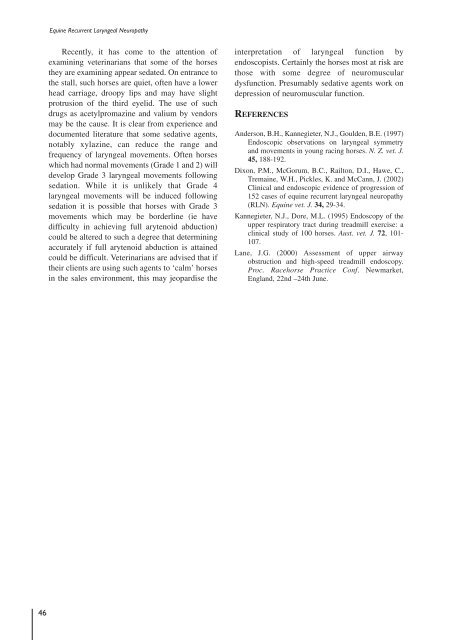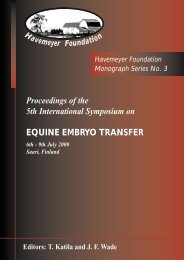Proceedings of a Workshop on - The Havemeyer Foundation
Proceedings of a Workshop on - The Havemeyer Foundation
Proceedings of a Workshop on - The Havemeyer Foundation
Create successful ePaper yourself
Turn your PDF publications into a flip-book with our unique Google optimized e-Paper software.
Equine Recurrent Laryngeal Neuropathy<br />
Recently, it has come to the attenti<strong>on</strong> <str<strong>on</strong>g>of</str<strong>on</strong>g><br />
examining veterinarians that some <str<strong>on</strong>g>of</str<strong>on</strong>g> the horses<br />
they are examining appear sedated. On entrance to<br />
the stall, such horses are quiet, <str<strong>on</strong>g>of</str<strong>on</strong>g>ten have a lower<br />
head carriage, droopy lips and may have slight<br />
protrusi<strong>on</strong> <str<strong>on</strong>g>of</str<strong>on</strong>g> the third eyelid. <strong>The</strong> use <str<strong>on</strong>g>of</str<strong>on</strong>g> such<br />
drugs as acetylpromazine and valium by vendors<br />
may be the cause. It is clear from experience and<br />
documented literature that some sedative agents,<br />
notably xylazine, can reduce the range and<br />
frequency <str<strong>on</strong>g>of</str<strong>on</strong>g> laryngeal movements. Often horses<br />
which had normal movements (Grade 1 and 2) will<br />
develop Grade 3 laryngeal movements following<br />
sedati<strong>on</strong>. While it is unlikely that Grade 4<br />
laryngeal movements will be induced following<br />
sedati<strong>on</strong> it is possible that horses with Grade 3<br />
movements which may be borderline (ie have<br />
difficulty in achieving full arytenoid abducti<strong>on</strong>)<br />
could be altered to such a degree that determining<br />
accurately if full arytenoid abducti<strong>on</strong> is attained<br />
could be difficult. Veterinarians are advised that if<br />
their clients are using such agents to ‘calm’ horses<br />
in the sales envir<strong>on</strong>ment, this may jeopardise the<br />
interpretati<strong>on</strong> <str<strong>on</strong>g>of</str<strong>on</strong>g> laryngeal functi<strong>on</strong> by<br />
endoscopists. Certainly the horses most at risk are<br />
those with some degree <str<strong>on</strong>g>of</str<strong>on</strong>g> neuromuscular<br />
dysfuncti<strong>on</strong>. Presumably sedative agents work <strong>on</strong><br />
depressi<strong>on</strong> <str<strong>on</strong>g>of</str<strong>on</strong>g> neuromuscular functi<strong>on</strong>.<br />
REFERENCES<br />
Anders<strong>on</strong>, B.H., Kannegieter, N.J., Goulden, B.E. (1997)<br />
Endoscopic observati<strong>on</strong>s <strong>on</strong> laryngeal symmetry<br />
and movements in young racing horses. N. Z. vet. J.<br />
45, 188-192.<br />
Dix<strong>on</strong>, P.M., McGorum, B.C., Railt<strong>on</strong>, D.I., Hawe, C.,<br />
Tremaine, W.H., Pickles, K. and McCann, J. (2002)<br />
Clinical and endoscopic evidence <str<strong>on</strong>g>of</str<strong>on</strong>g> progressi<strong>on</strong> <str<strong>on</strong>g>of</str<strong>on</strong>g><br />
152 cases <str<strong>on</strong>g>of</str<strong>on</strong>g> equine recurrent laryngeal neuropathy<br />
(RLN). Equine vet. J. 34, 29-34.<br />
Kannegieter, N.J., Dore, M.L. (1995) Endoscopy <str<strong>on</strong>g>of</str<strong>on</strong>g> the<br />
upper respiratory tract during treadmill exercise: a<br />
clinical study <str<strong>on</strong>g>of</str<strong>on</strong>g> 100 horses. Aust. vet. J. 72, 101-<br />
107.<br />
Lane, J.G. (2000) Assessment <str<strong>on</strong>g>of</str<strong>on</strong>g> upper airway<br />
obstructi<strong>on</strong> and high-speed treadmill endoscopy.<br />
Proc. Racehorse Practice C<strong>on</strong>f. Newmarket,<br />
England, 22nd –24th June.<br />
46








